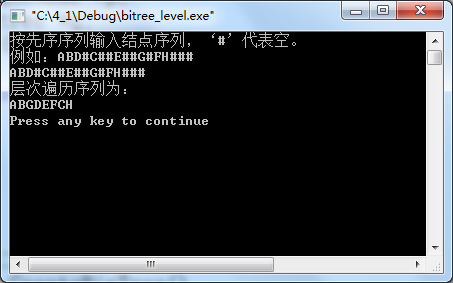#include <stdio.h>
#include <stdlib.h>
//定义二叉树的结点
typedef struct btnode
{
char data;
struct btnode *lchild,*rchild;
}bitree,*Bitree;
//队列结点的定义
typedef struct LinkQueueNode
{
bitree *data; //队列结点的数据域是二叉树的结点
struct LinkQueueNode *next;
}LKQueNode;
//定义队列
typedef struct LKQueue
{
LKQueNode *front,*rear;
}LKQue;
//初始化队列
void InitQueue(LKQue *LQ)
{
LKQueNode *p; //定义一个队列结点的指针
p=(LKQueNode *)malloc(sizeof(LKQueNode));//内存分配一个结点空间,由指针p指向
LQ->front=p;
LQ->rear=p;
LQ->front->next=NULL; //队头指针和队尾指针都指向新结点,并将新结点的指针域置空
}
//判断队列是否为空队列
int EmptyQueue(LKQue *LQ)
{
if(LQ->front==LQ->rear)
return 1;
else
return 0;
}
//入队操作
void EnQueue(LKQue *LQ,Bitree x) //入队元素为二叉树的整个结点
{
LKQueNode *p;
p=(LKQueNode *)malloc(sizeof(LKQueNode));
p->data=x; //二叉树的结点是队列结点的数据域
p->next=NULL;
LQ->rear->next=p;
LQ->rear=p;
}
//出队操作
int OutQueue(LKQue *LQ)
{
LKQueNode *s;
if(EmptyQueue(LQ))
{
exit(0);
return 0;
}
else
{
s=(LQ->front)->next;
(LQ->front)->next=s->next;
if(s->next==NULL)
LQ->rear=LQ->front;
free(s);
return 1;
}
}
//取队首元素
Bitree GetHead(LKQue *LQ) //队首结点的数据是二叉树的结点,所以要用Bitree声明函数
{ //类型
LKQueNode *p;
bitree *q;
if(EmptyQueue(LQ))
return q;
else
{
p=(LQ->front)->next;
return p->data;
}
}
//创建二叉树
Bitree CreateBinTree()
{
char ch;
Bitree t;
ch=getchar();
if(ch == '#')
t=NULL;
else
{
t=(Bitree)malloc(sizeof(bitree)); //分配二叉树的结点
t->data=ch;
t->lchild=CreateBinTree();
t->rchild=CreateBinTree();
}
return t;
}
//按层次遍历
void LevelOrder(Bitree T)
{
LKQue Q;
Bitree p;
InitQueue(&Q);
if(T!=NULL)
{
EnQueue(&Q,T);
while(!EmptyQueue(&Q))
{
p=GetHead(&Q);
OutQueue(&Q);
printf("%c",p->data);
if(p->lchild!=NULL)
EnQueue(&Q,p->lchild);
if(p->rchild!=NULL)
EnQueue(&Q,p->rchild);
}
}
}
//主函数
void main()
{
Bitree TT;
printf("按先序序列输入结点序列,‘#’代表空。
");
printf("例如:ABD#C##E##G#FH###
");
TT=CreateBinTree();
printf("层次遍历序列为:
");
LevelOrder(TT);
printf("
");
}
运行结果:
